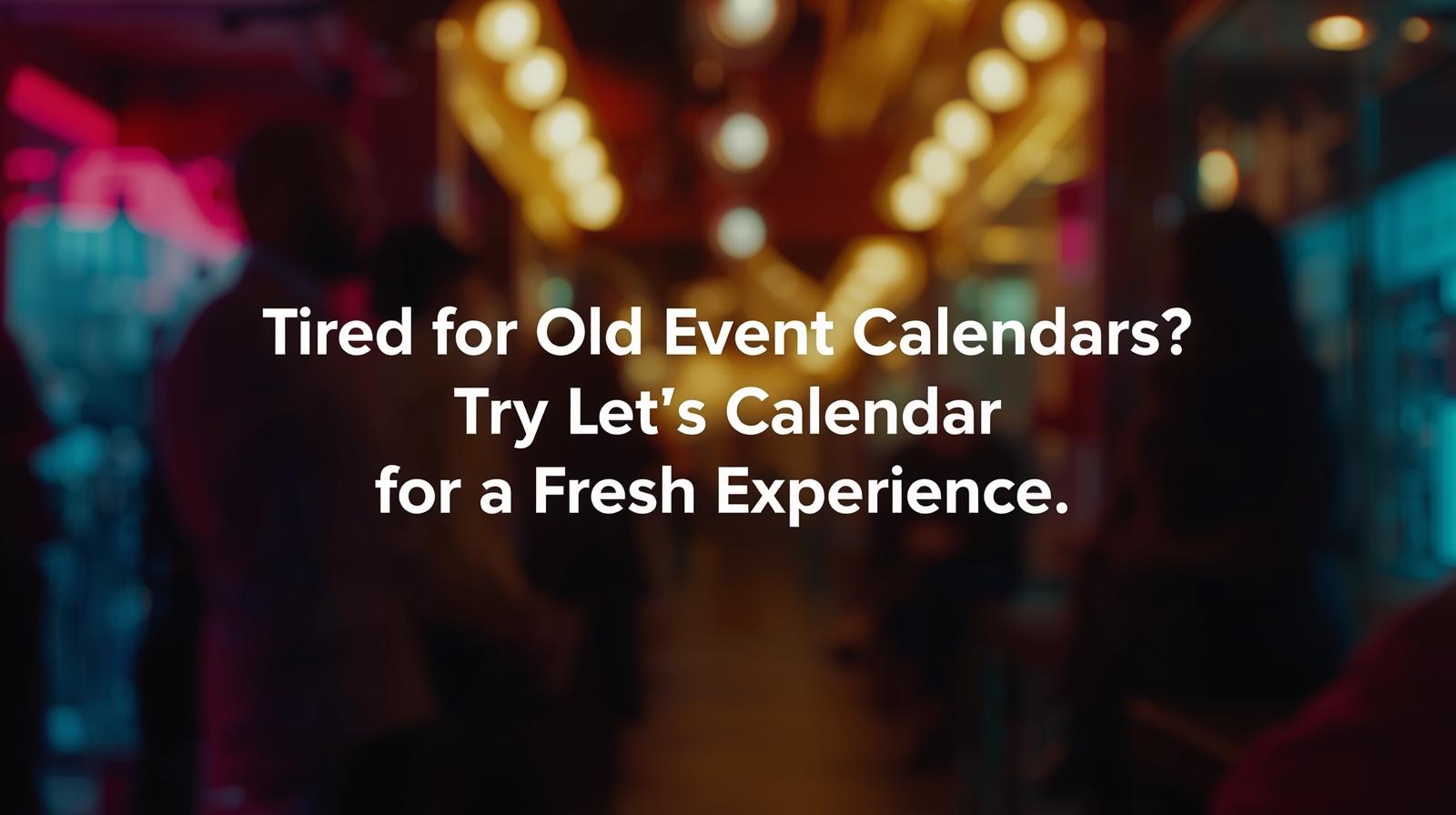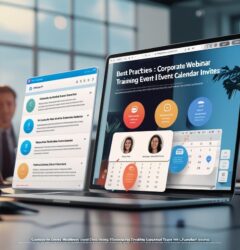- Email: [email protected]
- phone: +44 (0) 203 916 5117
17 Oct

Tired of Old Event Calendars? Try Let’s Calendar for a Fresh Experience
For years, event organizers have relied on the same old event calendars, clunky, limited, and often built for individuals, not for large-scale coordination. Whether you’re managing a webinar, an executive conference, or a series of client meetings, traditional platforms can make scheduling feel like an endless chore.
The modern event world needs more than just a static invite. It needs smart, personalized, and scalable scheduling the kind that works in real time and supports large audiences without chaos.
That’s where Let’s Calendar brings a fresh experience. It reimagines how professionals handle event invitations helping teams send bulk calendar invites, manage attendee engagement, and simplify event scheduling across Gmail, Outlook, and Google Calendar.
1. The Problem with Traditional Event Calendars
Event calendars were originally designed for individual use, perfect for keeping track of personal meetings, but not for managing complex event logistics. When you’re an organizer handling hundreds (or thousands) of participants, the cracks begin to show.
Common challenges include:
- Manual Scheduling Fatigue: Sending one invite at a time for large-scale events is inefficient.
- Limited Personalization: Old systems lack the ability to customize messages per invitee.
- Cross-Platform Confusion: Integrating with Outlook, Gmail, or Google Calendar can be messy.
- No Insight into Responses: Tracking RSVPs or cancellations becomes an endless spreadsheet task.
These limitations often result in lost invites, double-bookings, and miscommunication, not to mention, wasted time that could be better spent perfecting the event experience.
2. The Modern Organizer’s Needs Have Evolved
Event organizers today aren’t just scheduling; they’re strategizing. Every calendar invite is an opportunity to make an impression to inform, engage, and connect with the recipient in a meaningful way.
Key priorities for modern event teams:
- Bulk Scheduling: The ability to send mass calendar invites seamlessly, without risking delivery errors.
- Personalization: Including event-specific details relevant to each invitee.
- Integration: Working flawlessly across different platforms (Outlook, O365, Gmail, Google).
- Analytics: Understanding who accepted, declined, or engaged.
The calendar has become more than a utility, it’s now an engagement tool that reflects how professional and organized your brand is.
3. Why It’s Time for a Fresh Calendar Experience
In an industry driven by precision and timing, even small inefficiencies create ripple effects. Imagine running a large conference or webinar where:
- Speakers get the wrong session links.
- Attendees miss time zone conversions.
- Reminders arrive late or not at all.
These are everyday pain points for event organizers using outdated tools. A fresh calendar experience goes beyond scheduling, it empowers you to create a smoother, more controlled environment for every event stakeholder.
A modern platform like Let’s Calendar bridges this gap, offering tools that let organizers manage invitations discreetly, send bulk meeting invites in Gmail or Outlook, and maintain full visibility on invite engagement.
4. The Shift Toward Intelligent Scheduling
Technology has transformed every part of event planning except, until recently, the humble calendar invite. Now, intelligent scheduling is emerging as a new standard.
Here’s what defines this next-generation approach:
a. Centralized Event Management
Instead of juggling multiple tools, teams can now manage their sessions, meetings, and webinars from one place. You can plan, schedule, and monitor all activities in real time.
b. Bulk Invite Distribution
The ability to send bulk meeting invites in Outlook or Gmail means saving hours of manual effort. A single dashboard distributes hundreds of invitations accurately and securely.
c. Personalized Experience
Every calendar invite can carry contextual details, unique session links, personalized messages, or speaker introductions turning a simple invite into a powerful communication touchpoint.
d. Analytics-Driven Insights
Get real-time RSVP data, response tracking, and follow-up reminders to ensure every session runs on schedule.
5. Adding Events Across Let’s Calendar Platform
Here are updated and platform accurate steps & tips for adding your events/invites across different calendar systems, based on how Let’s Calendar currently works:
a. Within Let’s Calendar: Sending Invites via Campaigns
- Log into your Let’s Calendar account.
- In the sidebar, click “Campaigns” to open your list of campaigns.
- In Campaign List, find the campaign you want to send invites for, and click the Paper Plane icon (send invites action).
- After that, click Manage Invites → Send Invite.
- A pop-up dialog will appear showing how many new attendees will receive invites and how many credits remain.
- Confirm by clicking Send Invite this triggers the calendar invitations to be sent to the selected audience.
These steps ensure that your campaign-generated events reach recipients via calendar invites correctly and with visibility into your credits and attendees.
b. Exporting or Publishing to External Calendars
To ensure broad compatibility and smooth “Add to Calendar / AddEvent” workflows, here’s how organizers should structure event data:
- Generate an .ics file containing your event’s title, start & end times, time zone, description, and any attachments or URLs.
- Offer “Add to Calendar” or “AddEvent” buttons/links on your event page so users can click to import the event into their preferred calendar client (Google Calendar, Outlook, Apple Calendar, etc.).
- When constructing such links, use standard calendar URL parameters for date, time, and reminders so the event appears correctly across platforms.
- Test importing the .ics or “AddEvent” links in multiple calendars (Gmail/Google Calendar, Outlook desktop/web, mobile, etc.) to ensure formatting, timezone, and reminders work correctly.
c. Best Practices & Tips for Calendar Compatibility
- Always include time zone information in your event metadata, so recipients in other locations see correct timings.
- Use universal calendar format (.ics) when in doubt it’s widely supported across Google, Outlook, Apple, and more.
- If your event has recurring sessions or multiple time slots, include those recurrence rules properly in the .ics or link.
- For updates or cancellations, send out new calendar entries (with the same identifier) so recipients’ calendars update rather than creating duplicates.
- Always test on different devices (desktop, mobile) and calendar clients before mass distribution.
6. Crafting Better Calendar Invites for Engagement
Event organizers often underestimate how much an invite influences participation. A great calendar invite should do more than mark time it should tell a story.
Key Elements of an Engaging Invite:
- Clear Event Title: Make it specific (e.g., “CXO Leadership Summit 2025” instead of “Meeting”).
- Purpose Statement: A one-line summary of why it matters.
- Essential Details: Include links, times, and speaker information clearly.
- Visual Branding: Incorporate your event or company identity subtly within the invite description.
- Call-to-Action: Add “Confirm Attendance” or “Join Now” links for quick responses.
By refining these elements, organizers elevate simple calendar notifications into professional communication tools.
7. Balancing Personalization and Scale
One of the greatest challenges in event planning is scaling without losing the personal touch. Whether inviting 50 executives or 5,000 attendees, personalization creates stronger engagement.
Here’s how organizers strike that balance:
- Use templates that automatically populate details like session title, name, or region.
- Group similar attendee types (speakers, sponsors, delegates) for targeted communication.
- Review and test before deploying bulk sends.
By combining these techniques with smart calendar systems, teams can send bulk calendar invites in Google or Outlook while maintaining precision and professionalism.
8. Reimagining the Role of the Calendar in Event Success
Calendars are no longer passive scheduling tools, they’re interactive touchpoints that can shape attendee experience.
Consider these examples:
- A conference timer integrated with your session schedule keeps speakers on time.
- Automated reminders reduce drop-off rates for webinars.
- Follow-up calendar events nurture leads after the main session.
This integration between timing, personalization, and smart scheduling is transforming how events are managed globally.
9. Future of Event Scheduling: Predictive and Automated
Looking ahead, calendar management will become even more intelligent adapting to patterns, preferences, and participant behavior.
The next wave of features will include:
- AI-driven scheduling: Predict optimal times based on engagement data.
- Smart follow-ups: Auto-schedule debrief or networking sessions post-event.
- Dynamic updates: Instantly reflect real-time changes across platforms.
These advancements underline the importance of adopting systems that evolve with you, not ones that hold you back.
From Chaos to Clarity Why It’s Time to Move Forward
The days of managing scattered invites, double bookings, old event calendars and confused attendees are numbered. Today’s organizers need a calendar system that’s intelligent, connected, and effortless.
By adopting a fresh calendar experience, you can ensure that every meeting, webinar, or conference runs with precision from the first invite to the final reminder.
If you’ve been struggling with traditional scheduling, it’s time to embrace the future one where your calendar does more than just count dates. It drives meaningful engagement, simplifies communication, and gives your event the structure it deserves.









Recent Comments